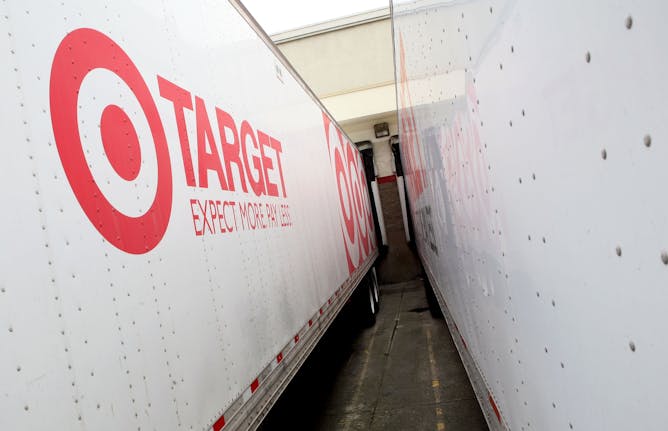|
Top headlines
Lead story
When people think of big polluters, they’re likely to picture the industrial owners of billowing smokestacks or pipes discharging gook into rivers. But the retail sector is coming under new attention for its environmental impacts, including both the goods it sells and the operations that move those products around.
Environmental historian Johnathan Williams has studied retail chain Target’s growth, its vast network of stores and distribution centers, and the trucks that service it. With a new rule just adopted in California that clamps down on air pollution from long-haul trucks servicing big warehouses – and with similar rumblings in New York state – Williams writes that the environmental impacts of big-box retail have become too big to ignore.
[ Miss us on Sundays? Get a selection of our best and most popular stories (or try our other weekly emails). ]
|

One of many trucks that move Target goods nationwide.
Justin Sullivan/Getty Images
Johnathan Williams, University of Northern Iowa
For decades, big-box retailers have evaded federal regulation of the pollution their operations generate. But a new air emission rule in Southern California could become a model for state controls.
|
Politics + Society
|
-
Calvin Schermerhorn, Arizona State University
Abortions happened in Arizona, despite a near-complete abortion ban enacted in 1864. But people also faced penalties for them, including a female doctor who went to prison.
-
Donald Nieman, Binghamton University, State University of New York
In 1974, the Supreme Court accepted, heard and decided a case within two months because the justices understood its importance to the public.
|
|
Economy + Business
|
-
Peter A. Coclanis, University of North Carolina at Chapel Hill; Leon Fink, University of Illinois Chicago
As of 2022, only Nigeria and Sudan had lower trade-to-GDP ratios.
-
Raymond Hogler, Colorado State University
There are better ways to keep employees on board, such as boosting pay and providing better benefits.
-
Miranda Kitterlin-Lynch, Florida International University
Conservatively speaking, workplace violence costs hundreds of millions of dollars each year.
|
|
Science + Technology
|
-
Chris Impey, University of Arizona
It’s not easy to collect rocks on a budget when the rocks are 140 million miles away.
-
Doug Cowen, Penn State
Tau neutrinos are notoriously difficult to spot in detectors like IceCube. But researchers have managed to isolate 7 candidates.
-
Sarah Florini, Arizona State University
TikTok is hardly a model social media platform, but it’s also far from an outlier when it comes to threats to Americans.
|
|
Education
|
-
Michael Cheng, Florida International University
A Miami nightclub owner and restaurateur has been adding star power to his class on entrepreneurship and hospitality.
|
|
Podcast 🎙️
|
-
Gemma Ware, The Conversation; Thabo Leshilo, The Conversation
The third and final part of our series What happened to Nelson Mandela’s South Africa on The Conversation Weekly podcast. Featuring interviews with Sithembile Mbete and Richard Calland.
|
|